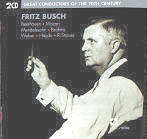Fritz Busch (1890 - 1951) – Beethoven: Leonora Overture II; Mozart: Symphony # 36 ("Linz"); Mendelssohn: Symphony # 4 ("Italian"); Brahms: Tragic Overture; Symphony # 2; Haydn: Sinfonia concertante; Struass: Don Juan.
I hope it's not a subconscious reflection of my antipathy to our namesake president, but this is a weak collection that discredits its subject.  Busch deserves to be remembered for his pioneering and deeply humanistic Glyndebourne Festival Mozart opera recordings of the mid-1930s (recently reissued by Naxos). The sensitivity of his 1936 London Don Juan here hints at Busch's fine work in that era. But all the other recordings are from the last four years of his life and unwittingly illustrate an important point. While the Leonora briefly flickers to life, the rest of these performances are good, solid, middle-of-the-road, competent readings, but nowadays that's just not much of a compliment – cruel, perhaps, but reflective of how far our musical culture has changed in the last century. When the only way to hear music was in live concert, the mere rarity of the experience was thrilling enough and the effort to produce even a minimally proficient performance deserved to be saluted. But with the advent of broadcasting and records our listening habits have shifted radically and the competitive stakes have risen considerably. Now we routinely immerse ourselves in performances that defy time and geography and the giants of the past are no longer relegated to memory but remain fresh and immediate to perpetually challenge all who would follow. Busch's late records are good but they're eclipsed by the superstars who provide that extra spark of care or inspiration. Sorry, but on the basis of this collection he simply doesn't belong in such rarified company.
Busch deserves to be remembered for his pioneering and deeply humanistic Glyndebourne Festival Mozart opera recordings of the mid-1930s (recently reissued by Naxos). The sensitivity of his 1936 London Don Juan here hints at Busch's fine work in that era. But all the other recordings are from the last four years of his life and unwittingly illustrate an important point. While the Leonora briefly flickers to life, the rest of these performances are good, solid, middle-of-the-road, competent readings, but nowadays that's just not much of a compliment – cruel, perhaps, but reflective of how far our musical culture has changed in the last century. When the only way to hear music was in live concert, the mere rarity of the experience was thrilling enough and the effort to produce even a minimally proficient performance deserved to be saluted. But with the advent of broadcasting and records our listening habits have shifted radically and the competitive stakes have risen considerably. Now we routinely immerse ourselves in performances that defy time and geography and the giants of the past are no longer relegated to memory but remain fresh and immediate to perpetually challenge all who would follow. Busch's late records are good but they're eclipsed by the superstars who provide that extra spark of care or inspiration. Sorry, but on the basis of this collection he simply doesn't belong in such rarified company.
A parting thought – the producers of the Great Conductors series were kind enough to answer my email inquiries. I feel compelled to mention this because it was an amazingly rare courtesy amid the aloof arrogance that has come to typify the attitude of so many of the major players in the record industry nowadays, an attitude which, as many readers of this site have expressed to me in frustration, is deeply resented. It's also ultimately self-defeating, as it alienates the most eager consumers in whose wallets the future of classical music retailing will rest. Anyway, it appears that the series has now come to its end. I'll continue to cherish most of the volumes, but at the same time I'm saddened that such an ambitious project now seems destined to stop short of being comprehensive, without Abendroth, Bernstein, Horenstein, Jochum, Knappertsbusch, Mengelberg, Paray, Solti, Strauss and others who, in many cases, were far more influential and produced a far more distinctive catalog of recordings than some of those who have been included. But despite my mixed feelings about the subjects and contents of some of the releases, I'm deeply grateful to have them at all, and so I must conclude by urging you to acquire them yourself, reach your own judgments and, above all, make your own discoveries.

Copyright 2003 - 2004 by Peter Gutmann